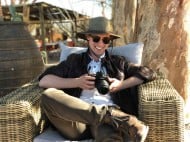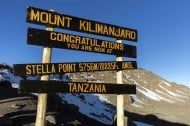
Visit the World’s Largest Human History Museum in Tanzania
Visit the World’s Largest Human History Museum in Tanzania
The origin of man. It’s one of the oldest and most debated topics out there. Where did we come from? How did we get here? What was the start of it all?
We are not yet able to answer those questions with certainty. But there are places in the world that give us little glimpses into the past. Many archaeologists have devoted their lives to digging through the earth for clues.
One such area is fast turning into one of the top Tanzania tourist attractions. It is called the Olduvai Gorge. A new museum rests directly on the archaeological site itself. It is full of exciting things to see and learn. Let’s take a look.
Top Tanzania Tourist Attractions
The following Tanzania Tourist attractions are excellent options:
Olduvai Gorge
The Olduvai Gorge in East Africa is an important piece of land. You can find it in the Great Rift Valley. It rests between the Ngorongoro Crater and the Serengeti National Parks.
It is important on both a national and international level to the study of human origins. Plus it holds the coveted title of a UNESCO World Heritage Site.
So what is so special about the Olduvai Gorge? What makes the area one of the most popular Tanzania tourist attractions?
Scientists have made some of the most significant discoveries in the study of human origins here. In fact, the spot hosts the earliest evidence of humans that scientists have found.
Scientists have found tons of fossilized bones, tools, and even footprints. Dating methods suggest that some of these remains may be almost 4 million years old.
From what they’ve found, scientists believe that human life began in this part of Africa.
The gorge itself looks to be about 30,000 years old. Volcanic and geologic activity along with streams of water carved out the huge gorge.
The deep gorge has already offered up quite a few amazing discoveries of human origins. Occasional geologic activity like earthquakes and floods continue to lay bare new pieces of the puzzle.

The First Discoveries
Olduvai Gorge first came on the radar in 1911. Professor Kattwinke, a German butterfly collector, stumbled upon an amazing find. He found the fossils of the Hipparion, an extinct 3-toed horse.
Inspired by Kattwinke’s discovery, Professor Hans Reid spent 3 months searching in 1923. He found lots of interesting remains but didn’t find anything too significant. The big discoveries were still waiting to happen.
Mary and Louis Leakey
Meet Mary and Louis Leakey. It’s impossible to talk about the discoveries in Olduvai Gorge without mentioning them. We’ll see why in a moment.
Louis’s parents were English but lived in Kenya as missionaries when he was born. Louis enjoyed birdwatching and often found prehistoric tools when he was out exploring.
After graduating the University of England, he joined an expedition hunting fossils. This trip awoke his interest in human origin studies.
Discoveries made in Olduvai Gorge were on display in the Berlin Museum. Louis Leakey saw them and decided to organize a trip. He invited Professor Reid to come along with him. But the big discovery was still eluding them.
Finally, in 1959, it was Louis’s wife, Mary Leakey, who actually made the grand discovery. She found the bone fragments of the skull of a hominid. They call this skull the Zinjanthropus skull.
They have pieced together these fragments to make up almost the entire skull. Experts believe the skull is about 1.75 million years old.
She went on to discover fossilized footprints at nearby Laetoli as well. These footprints are thought to be almost 4 million years old.
In all, Mary Leakey spent over 50 years working at Olduvai Gorge. Other impressive achievements include discovering 15 new animal species. Plus, a whole new genus.
These are the most significant discoveries that were made. But archaeologists have found plenty of other bones, fossils, and tools at the site.
The Museum
In 2017, the Olduvai Gorge Museum first opened its doors. It is already in position to be one of the top Tanzania tourist attractions.
In fact, Tanzania is already getting some major bonus points. This is now the largest human history museum built right on top of the archaeological site.
Visitors have already been coming by the thousands to visit the area. There is something in all of us that longs to see where we have come from. Now, with the new museum opening its doors, even more visitors will be flooding the area.
Visitors to the museum can view Mary Leakey’s Zinjanthropus skull. The Laetoli footprints are also on display. All the other discoveries that have been made at Olduvai Gorge are also on display.
Plus, visitors can view findings, artifacts, and replicas from other sites in Africa. Expect to see exhibits from other parts of Tanzania, Ethiopia, Kenya, South Africa and more.
Other famous discoveries are also on display here. You may remember learning about “Lucy” in high school. She is the oldest, most complete human ancestor skeleton that experts have found to date. Archaeologists found her in Ethiopia and believe her to be about 3.2 million years old.
The museum also has an exhibit honoring Mary Leakey. Her work was so influential that curators thought she deserved a spot. Visitors can see some of her personal effects, tools that she used, and souvenirs.
Top Tanzania Tourist Attractions
Without a doubt, the Olduvai Gorge Museum is one of Tanzania’s top tourist attractions. School groups, researchers, academicians and tourists alike flock to the site.
Why wouldn’t they? Olduvai Gorge holds answers to the mysteries of the origin of man. The nearby Ngorongoro Crater has breathtaking herds of wildlife roaming the land. And the rich culture of the Maasai cattle herders is fascinating to see.
The area has earned itself a couple distinguished nicknames. The “Eighth Wonder of the World” and “The Last Garden of Eden”.
To discover this breathtaking corner of the world, check out our Tanzania safaris. Feel free to contact us with any questions. We want to make your trip to Tanzania something you’ll remember for a lifetime!


